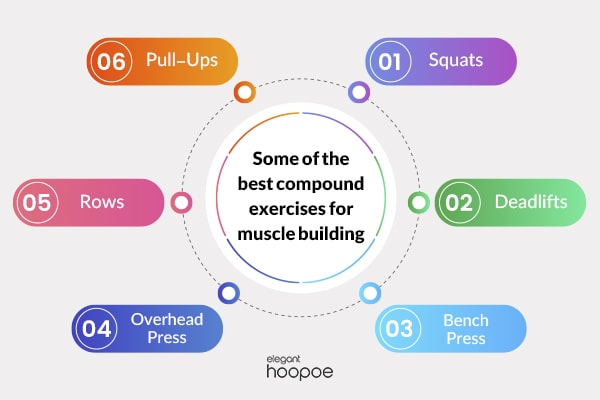How to Gain Muscle Fast? Key Strategies for Effective Muscle Growth
Want to know how to gain muscle efficiently? Follow these key strategies:
- Strength Training: Focus on compound exercises like squats, deadlifts, and bench presses. Aim for 8-12 reps per set with progressive overload.
- Protein Intake: Consume at least 1g of protein per pound of body weight daily from sources like chicken, fish, and dairy.
- Caloric Surplus: Eat 250-500 extra calories per day to fuel muscle growth, prioritizing nutrient-dense foods.
- Rest & Recovery: Allow muscles to repair by getting enough sleep and incorporating rest days.
By combining these strategies, you can build muscle effectively and sustain long-term progress.
How to build muscle? Building muscle is a process that involves strength training exercises, proper nutrition, and adequate rest and recovery. It is a popular goal for many people who want to improve their physical fitness, strength, and appearance.
Muscles are essential for daily movement and physical activities, and building muscle can also help to boost metabolism and burn fat. However, building muscle requires time, effort, and commitment, as well as a clear understanding of the principles and techniques involved.
In this guide, we will explore: How to build muscle? The fundamentals of building muscle, including the best exercises, reps and sets, nutrition, and supplements to help you achieve your goals.
How to Gain Muscle Mass?

When it comes to building muscle, reps, sets, and weight are important factors to consider and can vary depending on individual factors such as age, fitness level, and training experience. It’s also essential to ensure proper form and technique when performing exercises to prevent injury and maximize results.
Here’s what you need to know:
- Reps: Reps refer to the number of times you perform a movement or exercise. For muscle building, it’s generally recommended to perform 8-12 reps per set. This range is optimal for muscle hypertrophy, as it allows for sufficient stress on the muscle fibers while also minimizing the risk of injury.
- Sets: Sets refer to the number of times you perform a given number of reps. For muscle building, it’s recommended to perform 3-5 sets per exercise. This provides enough stimulus for muscle growth while also allowing for adequate recovery time between sets.
- Weight: The weight you use for a given exercise will depend on your strength level and goals. For muscle building, it’s recommended to use a weight that challenges you but still allows you to complete the desired number of reps with good form. As you progress, gradually increasing the weight can help to stimulate further muscle growth.
It is important to consult a healthcare professional before embarking on any weight loss program, especially if seeking to lose weight fast.
Body recomposition techniques
To lose fat and gain muscle you need an effective plan. An effective muscle-building plan involves proper nutrition, exercise, and recovery. For some, it may seem overwhelming, but with the right approach, it can be achieved.
Progressive overload is the key
Progressive overload is one of the fundamentals of gaining muscle mass, as it implies gradually increasing the weight, reps, or sets of your exercise over time so that your muscles are constantly being challenged. This stimulates muscle growth, which is essential for gaining muscle mass.

When you want to incorporate progressive overload into your workout routine, you can start by increasing the weight or reps of your exercises every two weeks, so that your muscles are being challenged and grow as a result of that exercise.
Make sure you consume enough protein
The consumption of enough protein is essential for muscle growth and gaining muscle, and it is necessary for you to consume enough protein to gain muscle. Experts recommend consuming 1 gram of protein per pound of body weight on a daily basis. It means if you weigh 150 pounds, you should consume 150 grams of protein every day.
A number of protein-rich foods are available in the diet, including chicken, beef, fish, eggs, dairy products, beans, and legumes. Eating these foods on a regular basis can help you meet your daily protein requirements.
How much calorie is good for gaining muscle?
You need to consume more calories than you burn to gain muscle. This is known as a calorie surplus, which gives your body the energy it needs to build muscle. You will need a different number of calories to gain muscle based on a number of factors, including your age, gender, weight, height, and activity level.
A healthy adult should consume 250-500 extra calories per day over their maintenance calorie level in order to gain muscle mass. Your maintenance calorie level is the amount of calories your body needs to maintain its current weight and level of activity. Online calorie calculators can be used to calculate your calorie requirement based on your age, gender, weight, height, and level of activity.

Despite the fact that you need to eat more calories to gain muscle, excessive eating can result in unwanted fat gain. Rather than eating excessive calories, focus on eating nutrient-dense foods like lean proteins, whole grains, fruits, and vegetables, which will provide your body with the nutrients it needs to grow muscles.
To keep your body fueled and promote muscle growth, you should also spread out your calorie intake throughout the day by consuming small meals and snacks every 3-4 hours. As protein is essential for muscle repair and growth, consume at least 1 gram of protein per pound.
As a way to ensure that you consume the recommended amount of calories in your diet to lose belly fat and gain muscle, you should pay attention to incorporating whole, nutrient-dense food into your diet, including fruits, vegetables, whole grains, lean protein, and healthy fats.
Prioritize Compound Exercises
Exercises involving multiple muscle groups at the same time are known as compound exercises. For example, squats, deadlifts, bench presses, and pull-ups. These exercises are essential for gaining muscle mass as they stimulate muscle growth in a variety of different parts of the body at the same time.
You can optimize muscle mass by incorporating compound exercises into your workout routine. Compound exercises should be performed at the start of your workout when you have the most energy to do them.
Rest and recover enough
There is no doubt that rest and recovery are crucial components of gaining muscle mass. The muscles need time to recover and repair after a workout, and this leads to muscle growth.
You should ensure that you are getting enough sleep by scheduling rest days into your workout routine. During rest days, you should engage in low-intensity exercises such as stretching, yoga, or walking. Furthermore, you should prioritize getting enough sleep, as all muscle growth takes place when you sleep.
Strength training for muscle building
We must say that strength training is one of the most effective ways to build muscle. This training stimulates muscle fibers to grow and adapt, leading to increased muscle size, strength, and endurance.

In addition to building muscle, strength training can also improve bone density, joint health, and overall physical performance. It can help to prevent age-related muscle loss and reduce the risk of injuries.
Strength training can be done using a variety of exercises, including compound exercises such as squats, deadlifts, bench presses, pull-ups, and rows. Isolation exercises such as bicep curls and tricep extensions can also be effective when combined with compound exercises.
When done consistently and with proper form, strength training can be a powerful tool for building muscle and improving overall health and fitness.
Best Compound Exercises to Gain Muscle Mass
Compound exercises are multi-joint movements that engage multiple muscle groups at once, making them highly effective for building muscle mass and strength. Incorporating compound exercises into your workout routine can help to maximize muscle growth and improve overall stability and performance. It is better to know that some quick fat-loss exercises refer to a set of physical activities designed to burn calories and increase metabolism to promote rapid weight loss.

Some of the best compound exercises for muscle building include:
- Squats: This exercise targets the lower body, including the quads, hamstrings, and glutes. It also works the core muscles.
- Deadlifts: Deadlifts target the lower back, glutes, hamstrings, and quadriceps. It is one of the best exercises for building overall strength and muscle mass.
- Bench Press: This exercise targets the chest, shoulders, and triceps.
- Pull-Ups: Pull-ups target the back, biceps, and shoulders. They are also excellent exercises for improving grip strength.
- Rows: Rows target the back muscles, including the lats and upper back. They also engage the biceps and shoulders.
- Overhead Press: This exercise targets the shoulders, triceps, and upper chest.
How to Build Muscle with Isolation exercises
While compound exercises are highly effective for building muscle mass and strength, isolation exercises can be useful for targeting specific muscle groups and enhancing muscle definition. However, it’s essential to prioritize compound exercises for building overall muscle mass and strength before focusing on isolation exercises.
Some of the best isolation exercises for muscle building include:
- Bicep curls: Bicep curls target the biceps and can be performed using dumbbells, resistance bands, or a cable machine.
- Tricep extensions: Tricep extensions target the triceps and can be performed using dumbbells, a cable machine, or an overhead barbell.
- Leg curls: Leg curls target the hamstrings and can be performed using a machine or resistance band.
- Leg extensions: Leg extensions target the quadriceps and can be performed using a machine or resistance band.
- Calf raises: Calf raises target the calf muscles and can be performed using bodyweight, dumbbells, or a machine.
Lifting heavy vs. light weights for muscle building

Lifting heavy weights and lifting light weights can both be effective for building muscle, but they target different aspects of muscle growth.
Heavy weight lifting with lower reps (around 1-5 reps per set) can be effective for building overall strength and muscle size. This type of training stimulates the nervous system and enhances neuromuscular coordination, which leads to increased strength and power output.
On the other hand, lifting light weights with higher reps (around 12-15 reps per set) can be effective for building muscle endurance, metabolic stress, and muscle definition. This type of training creates more metabolic stress, which leads to increased blood flow, nutrient delivery, and waste removal from the muscles. It also enhances muscular endurance and can improve muscular definition.
Both heavy and light lifting can be effective for muscle building, and the best approach depends on your individual goals and preferences. For optimal results, it’s recommended to incorporate a mix of heavy and light lifting into your workout routine, with a focus on progressive overload over time. Gradually increasing the weight or resistance you use for a given exercise can help to stimulate muscle growth and avoid plateaus.
Frequency of workouts for muscle building

So how often should you workout for muscle growth? The frequency of workouts for muscle building can depend on a variety of factors such as individual goals, training experience, and recovery capacity. Here are some general guidelines for workout frequency for muscle building:
- Beginners: If you’re new to strength training, it’s recommended to start with two to three full-body workouts per week, with at least one day of rest between workouts. This allows for adequate recovery and adaptation to the training stimulus.
- Intermediate: If you have some training experience, it’s recommended to increase the frequency to three to four workouts per week, focusing on split routines that target specific muscle groups on different days. This allows for more targeted training and greater training volume.
- Advanced: For advanced lifters, it’s recommended to train five to six times per week, with a combination of full-body and split routines. This allows for more frequent training and greater training volume, but it’s essential to ensure adequate recovery and avoid overtraining.
It’s essential to listen to your body, prioritize recovery, and adjust your training frequency as needed to avoid injury and optimize results. It’s also recommended to incorporate rest days and active recovery into your workout routine to allow for adequate recovery and prevent burnout.

Diet and nutrition plan for building muscle mass
Nutrition is a critical factor in muscle building, as it provides the necessary nutrients for muscle repair, growth, and recovery. Here are some key nutrition tips for building muscle:
- Consume enough protein: Protein plays a crucial role in muscle building, as it provides the amino acids necessary for muscle repair, growth, and maintenance. Aim to consume 1-1.5 grams of protein per pound of body weight per day, spread out across multiple meals.
- Eat a balanced diet: In addition to protein, it’s important to consume a variety of nutrient-dense foods such as fruits, vegetables, whole grains, and healthy fats. These foods provide the vitamins, minerals, and antioxidants necessary for optimal health and muscle growth.
- Stay hydrated: Adequate hydration is crucial for muscle function and recovery. Aim to drink at least 8-10 glasses of water per day, and more if you are physically active.
- Time your meals appropriately: Eating a protein-rich meal before and after your workout can help to support muscle repair and growth. Aim to eat a meal containing carbohydrates and protein within 30 minutes of finishing your workout.
Overall, a balanced diet rich in protein, whole foods, and adequate hydration is crucial for building muscle. By fueling your body with the right nutrients and timing your meals appropriately, you can support muscle growth and optimize your workouts.
Protein for building muscle
When you lift weights or engage in resistance training, you create small tears in your muscle fibers. Protein helps to repair these tears and stimulate muscle growth, leading to increased muscle size and strength over time.

Here are some key roles that protein plays in muscle building:
- Protein is made up of amino acids, which are the building blocks of muscle tissue. Consuming adequate protein provides the necessary amino acids for muscle repair, growth, and maintenance.
- Muscle protein synthesis is the process by which new muscle tissue is formed. Consuming protein after a workout can increase muscle protein synthesis, leading to greater muscle growth and recovery.
- Consuming adequate protein can help to prevent muscle breakdown, which can occur during intense workouts or periods of calorie restriction. Protein helps to maintain muscle mass and prevent muscle loss.
- Adequate protein consumption can support recovery and reduce muscle soreness after a workout. This can help to improve overall performance and make it easier to stick to a consistent workout routine.

Common mistakes to Avoid When Building Muscle
Building muscle can be a challenging process that requires dedication, consistency, and attention to detail. Here are some common mistakes to avoid when building muscle:
- Not prioritizing nutrition: Proper nutrition is essential for muscle building, and failing to eat enough calories or macronutrients can hinder progress. It’s important to prioritize a balanced diet that provides adequate protein, carbohydrates, and healthy fats to support muscle growth and recovery.
- Overtraining: While it’s important to train consistently, overtraining can be counterproductive and can lead to decreased performance, increased risk of injury, and decreased muscle growth. It’s important to prioritize rest and recovery and to avoid training the same muscle groups too frequently.
- Neglecting compound exercises: Compound exercises are essential for building muscle, as they engage multiple muscle groups and stimulate greater muscle growth. Neglecting compound exercises in favor of isolation exercises can limit overall progress.
- Not tracking progress: Tracking progress is essential for optimizing muscle growth, and failing to track progress can make it difficult to make informed decisions about training and nutrition. It’s important to track variables such as weight lifted, reps, sets, and body composition to ensure continued progress over time.
- Focusing too much on supplements: While certain supplements can be helpful for muscle building, they should not be relied on as a replacement for proper nutrition and training. Focusing too much on supplements can distract from the importance of nutrition, training, and recovery in building muscle.
- Inconsistency: Consistency is key for building muscle, and failing to train or eat consistently can hinder progress. It’s important to prioritize a consistent workout routine and nutrition plan to optimize muscle growth and recovery.
By avoiding these common mistakes and prioritizing proper nutrition, training, and recovery, you can optimize your muscle-building progress and achieve your desired results over time.
Other methods to gain muscle
besides exercising and following a diet which are crucial for weight loss and gaining muscle, there are other methods which can help us build more muscle mass in a shorter period. For instance electrical muscle stimulation or EMS is a new method that many body shaping devices use to force multiple contracts to the muscle tissue. Using EMS technology can help those who would want to reach their goal faster and in a safe way.
Staying Motivated
Staying motivated in muscle building can be challenging, especially when progress seems slow or when facing obstacles. Here are some tips for staying motivated in muscle building:
- Set clear and specific goals: Setting clear and specific goals can provide a sense of direction and purpose in muscle building. Whether it’s gaining a certain amount of muscle mass or lifting a certain weight, having a specific goal can help motivate you to push through tough workouts and stay consistent with your training and nutrition.
- Track progress: Tracking progress can provide a sense of accomplishment and motivation by showing the progress you’ve made over time. It’s important to track variables such as weight lifted, reps, sets, and body composition to ensure continued progress and to celebrate your accomplishments along the way.
- Find a workout partner or community: Working out with a partner or joining a community can provide motivation and support during muscle building. Having someone to share your journey with can make workouts more enjoyable and can provide accountability and encouragement when facing challenges.
- Mix up your workouts: Keeping your workouts varied and challenging can prevent boredom and maintain motivation in muscle building. Try new exercises, increase the weight or reps, or switch up your training routine to keep things interesting and challenging.
- Focus on the process, not just the outcome: While it’s important to have goals, focusing too much on the outcome can create undue pressure and stress. Instead, focus on the process of muscle building, including proper nutrition, consistent training, and rest and recovery. Celebrate the small victories along the way and trust the process to achieve your desired results over time.
By implementing these strategies and finding what works best for you, you can stay motivated and committed to muscle-building and achieve your desired results over time.
Concluding Remarks: How to Build Muscle
In conclusion, building muscle requires a combination of proper nutrition, consistent training, and rest and recovery. Compound exercises should be prioritized, and weightlifting should be progressive to challenge the muscles and stimulate growth.
In this article, we tried our best to provide you with information about how to build muscle and reach your ideal body; We hope that by reading this article you will be able to gain muscle.
If you are bored with programs and diets! You can lose 25% of your fat thickness in just one 15-minute session with elegant hoopoe slimming devices! We are a slimming clinic operating in UAE, Dubai, Jumeirah 2. We look forward to meeting you to get you into the body you’ve been dreaming of.






